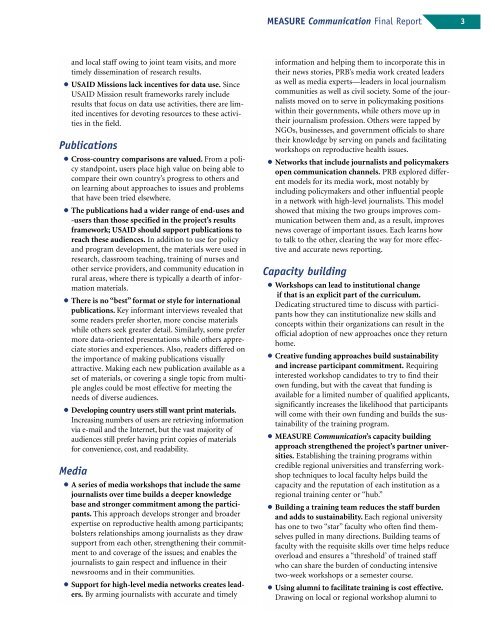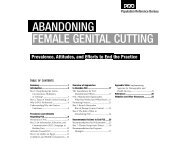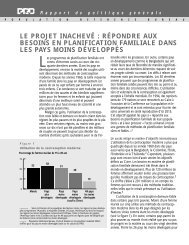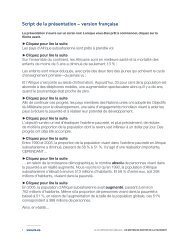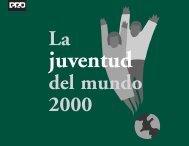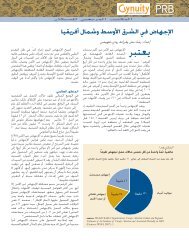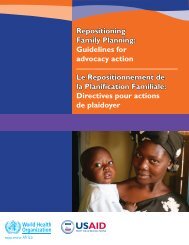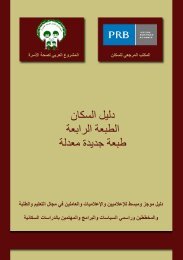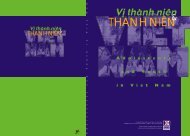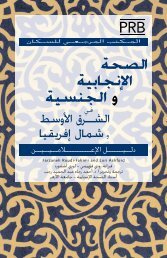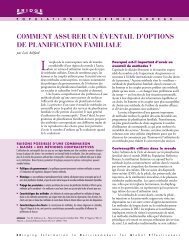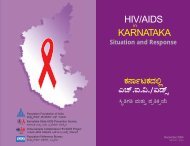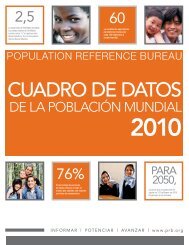MEASURE Communication Final Report - Population Reference ...
MEASURE Communication Final Report - Population Reference ...
MEASURE Communication Final Report - Population Reference ...
You also want an ePaper? Increase the reach of your titles
YUMPU automatically turns print PDFs into web optimized ePapers that Google loves.
<strong>MEASURE</strong> <strong>Communication</strong> <strong>Final</strong> <strong>Report</strong><br />
3<br />
and local staff owing to joint team visits, and more<br />
timely dissemination of research results.<br />
● USAID Missions lack incentives for data use. Since<br />
USAID Mission result frameworks rarely include<br />
results that focus on data use activities, there are limited<br />
incentives for devoting resources to these activities<br />
in the field.<br />
Publications<br />
● Cross-country comparisons are valued. From a policy<br />
standpoint, users place high value on being able to<br />
compare their own country’s progress to others and<br />
on learning about approaches to issues and problems<br />
that have been tried elsewhere.<br />
● The publications had a wider range of end-uses and<br />
-users than those specified in the project’s results<br />
framework; USAID should support publications to<br />
reach these audiences. In addition to use for policy<br />
and program development, the materials were used in<br />
research, classroom teaching, training of nurses and<br />
other service providers, and community education in<br />
rural areas, where there is typically a dearth of information<br />
materials.<br />
● There is no “best” format or style for international<br />
publications. Key informant interviews revealed that<br />
some readers prefer shorter, more concise materials<br />
while others seek greater detail. Similarly, some prefer<br />
more data-oriented presentations while others appreciate<br />
stories and experiences. Also, readers differed on<br />
the importance of making publications visually<br />
attractive. Making each new publication available as a<br />
set of materials, or covering a single topic from multiple<br />
angles could be most effective for meeting the<br />
needs of diverse audiences.<br />
● Developing country users still want print materials.<br />
Increasing numbers of users are retrieving information<br />
via e-mail and the Internet, but the vast majority of<br />
audiences still prefer having print copies of materials<br />
for convenience, cost, and readability.<br />
Media<br />
● A series of media workshops that include the same<br />
journalists over time builds a deeper knowledge<br />
base and stronger commitment among the participants.<br />
This approach develops stronger and broader<br />
expertise on reproductive health among participants;<br />
bolsters relationships among journalists as they draw<br />
support from each other, strengthening their commitment<br />
to and coverage of the issues; and enables the<br />
journalists to gain respect and influence in their<br />
newsrooms and in their communities.<br />
● Support for high-level media networks creates leaders.<br />
By arming journalists with accurate and timely<br />
information and helping them to incorporate this in<br />
their news stories, PRB’s media work created leaders<br />
as well as media experts—leaders in local journalism<br />
communities as well as civil society. Some of the journalists<br />
moved on to serve in policymaking positions<br />
within their governments, while others move up in<br />
their journalism profession. Others were tapped by<br />
NGOs, businesses, and government officials to share<br />
their knowledge by serving on panels and facilitating<br />
workshops on reproductive health issues.<br />
● Networks that include journalists and policymakers<br />
open communication channels. PRB explored different<br />
models for its media work, most notably by<br />
including policymakers and other influential people<br />
in a network with high-level journalists. This model<br />
showed that mixing the two groups improves communication<br />
between them and, as a result, improves<br />
news coverage of important issues. Each learns how<br />
to talk to the other, clearing the way for more effective<br />
and accurate news reporting.<br />
Capacity building<br />
● Workshops can lead to institutional change<br />
if that is an explicit part of the curriculum.<br />
Dedicating structured time to discuss with participants<br />
how they can institutionalize new skills and<br />
concepts within their organizations can result in the<br />
official adoption of new approaches once they return<br />
home.<br />
● Creative funding approaches build sustainability<br />
and increase participant commitment. Requiring<br />
interested workshop candidates to try to find their<br />
own funding, but with the caveat that funding is<br />
available for a limited number of qualified applicants,<br />
significantly increases the likelihood that participants<br />
will come with their own funding and builds the sustainability<br />
of the training program.<br />
● <strong>MEASURE</strong> <strong>Communication</strong>’s capacity building<br />
approach strengthened the project’s partner universities.<br />
Establishing the training programs within<br />
credible regional universities and transferring workshop<br />
techniques to local faculty helps build the<br />
capacity and the reputation of each institution as a<br />
regional training center or “hub.”<br />
● Building a training team reduces the staff burden<br />
and adds to sustainability. Each regional university<br />
has one to two “star” faculty who often find themselves<br />
pulled in many directions. Building teams of<br />
faculty with the requisite skills over time helps reduce<br />
overload and ensures a “threshold’ of trained staff<br />
who can share the burden of conducting intensive<br />
two-week workshops or a semester course.<br />
● Using alumni to facilitate training is cost effective.<br />
Drawing on local or regional workshop alumni to


